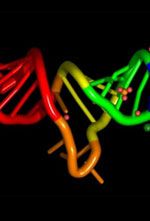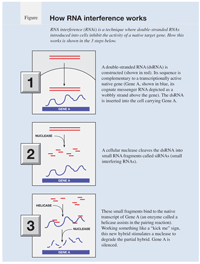Publication
Article
Psychiatric Times
Elegant Knockdowns, DISC1, and Schizophrenia
Author(s):
When I was a grad student-back in the Jurassic Era of molecular manipulations-my lab mates and I were all transfixed by the notion of a new technology: knockout animals (KOAs). This was because of its promise to solve a vexing problem.

When I was a grad student-back in the Jurassic Era of molecular manipulations-my lab mates and I were all transfixed by the notion of a new technology: knockout animals (KOAs). This was because of its promise to solve a vexing problem. It was common in those days to isolate lots of genes, but determining their function was often a bewildering exercise. Not enough sequences had yet been placed in a database to make rational structure/function inferences using a computer. You could isolate a gene and then spend the rest of your life trying to figure out what it did.
That all began to change with KOAs. Using a variety of embryonic and molecular manipulations, it became possible to create genetically identical mice with typical populations with 1 critical exception: they were missing a single gene-your gene-if you knew how to make the animal. Your hypotheses about your gene’s function stood on much more solid ground with a simple inspection of the KOA’s anatomy, behavior, or both.
As useful as the technique became, it wasn’t a panacea; for people interested in developmental issues, knockout technologies always had a couple of annoying features. First was the inadvertent lethality problem. Many important genes play critical roles in the viability of the embryo, and if you knocked out these genes, the animal died. Not lots of utility there, particularly if you wished to look at postpartum behavior.
Second was the specificity problem. Gene products are usually expressed in many tissues. They even change functions depending on the developmental stage of the animal. Most investigators aren’t interested in the entire resum of a given protein, just the biological tasks currently being funded. When you create a KOA, you literally knock out the gene in every cell, not just in the tissue of interest. Not much specificity there. In the early days, knockout procedures could be performed with a very blunt instrument-a surprisingly risky investment. There was no guarantee you would get a living animal after the manipulation and no guarantee you could extract precise informa-tion from it if the creature somehow survived.
Things have changed radically in the ensuing years. More subtle molecular manipulations are available to people interested in, say, the distance between genes and behaviors. I would like to describe the fruit of one such technique. Describing the data won’t take much time, but we must review some basic molecular biology and a few techniques to understand what happened.
FOUR PIECES OF BACKGROUND INFORMATION
GFP
Short for green fluorescent protein, GFP is obtained from jellyfish; the protein encoded by this gene has a so-called reporter function. Its hallmark characteristic is an ability to turn any cell expressing it a bright green color. This “reporting” can be quite useful. GFP can be hooked up to the promoter sequence-an on/off switch-of a gene whose regulation is being studied, then placed inside a cell. If the cell turns green, the investigator knows the promoter was activated in that cellular background. The 3 researchers who discovered and characterized GFP (Osamu Shimomura, Martin Chalfie, and Roger Y. Tsien) were awarded the 2008 Nobel Prize in Chemistry for their efforts.
Injection, followed by electroporation
It is one thing to construct a gene sequence using GFP; it is another to get that sequence solely into the nucleus of target cells of interest, and no others. The specificity problem mentioned with knockouts has been solved in a variety of ways, one of which is physical injection of the gene into the target region, followed by electroporation. Suppose you wanted to get GFP into the cells of a specific region of the brain of a lab animal, and in no other place. The first step is simply to inject the sequence of interest into the tissues you wish to target. This step does not put the gene sequence into the cells but simply places them near the desired location.
Next comes the electroporation step. Electroporation is a well-established technique whereby cells are exposed to an externally applied electrical field. Also called electropermeabilization, the field transiently opens up the cell plasma membrane, allowing foreign genes entrance into the cytosol. A certain percentage of cells that internalize the foreigner allows the genetic construct into the nucleus, where it becomes integrated into the host chromosome.
There are both desktop and handheld versions of these machines. In the handheld version, paddles mediating the electric field are supplied to either side of the target tissue. A current is then applied, opening up only those local cells. If the region has been previously injected with the gene construct of interest, say a GFP construct, some will find their way into the electroporated tissues. With the proper manipulation, they will begin to glow green. The gene of interest has been inserted into the tissue of interest, and in no other place. A version of this technology has been developed to allow for the insertion of genes into developing embryos. It is called in utero electroporation (IUEP).

RNAi and shRNA
RNAi stands for RNA interference. This technique exposes cells to a double-stranded RNA construct complementary to some target gene. This construct then triggers the degradation of the messenger RNA (mRNA) of the native target gene, thereby rendering it incapable of making protein. Indirect silencing occurs by the construct-stimulated activation of an interior nuclease (Figure). This protein degrades any mRNA sequence that is complementary to either strand of the introduced construct. It is a terrific way to transiently silence a specific gene. Like GFP, the elucidation of this technique led researchers Andrew Fire and Craig Mello to a Nobel Prize in 2006 (Physiology or Medicine).
A related construct and technology involves using an RNA construct called short hairpin RNA (shRNA). This, too, is engineered to be complementary to a gene of interest-and it, too, is double-stranded. Although synthesized as a linear sequence, its double-stranded nature occurs because of the construct’s tendency to auto-anneal, forming a tight, hairpin loop. This loop can be used to silence gene expression via the same interfering RNA system mentioned above.
DISC1 gene
The protein of the developmentally regulated Disrupted-in-Schizophrenia-1 (DISC1) gene is involved in a wide variety of neurological processes in the developing mammalian brain. Mutations in DISC1 have been associated with a predisposition for schizophrenia (and other mood disorders), hence its name. DISC1 is expressed in discrete tissues in the mouse brain during 2 developmental phases. One occurs in utero, during early brain development; the second, at the onset of puberty.
We now have the ingredients necessary to explain a truly powerful finding involving DISC1, puberty, and the developing cortex of a mouse. By transiently altering the expression of DISC1, you can induce behaviors reminiscent of schizophrenia.
THE DATA
Using IUEP, GFP was bilaterally introduced into mouse lateral ventricles at day 14 postconception (called E14, for embryonic day). By day P56 (postnatal, 56th day), green cells were observed at many cortical sites, including the medial prefrontal cortex (mPFC), dorsolateral prefrontal cortex (dlPFC), orbitofrontal cortex (OFC), and anterior cingulate. This confirmed that with the introduction of foreign genes into the lateral ventricles during embryonic growth, expression could be observed in cortical regions long after birth.1 The constructs were found to be integrated into a lineage of pyramidal neurons.
What would happen if you performed an IUEP experiment at E14 with a green reporter gene, accompanied by an shRNA to DISC1? This would allow transient blocking of DISC1 expression at a time when the cells were forming critical cortical structures. This experiment was done, and preliminary data showed you could indeed get transient blocking of DISC1 expression in green cells using the technologies just described. Once again expressed primarily in pyramidal cells, the suppression of native DISC1 was shown not to be permanent. DISC1 was inhibited for 7 days postinjection but was found to be fully recovered, expressing in a normal pattern 3 weeks later.
This technique is very different from your standard KOAs. In fact, the technique is called “knockdown” to indicate this transient inhibition. What did the brain of these mice look like? How did the mice behave?
The researchers found some extraordinary things. The physical architecture of the cortex of these knockdowns was greatly affected, as were certain metabolic features. Dendritic cell abnormalities normally associated with apoptosis were found in cortical structures at P14 in the experimentals. Intriguingly, anomalies in the projection patterns of the mesocortical dopaminergic neurons to the mPFC were found in the knockdowns at P56, but not in the controls. There were decreases in the extracellular concentrations of dopamine in the mPFC, too, but not in other regions of the brain (the cerebellum and the nucleus accumbens had typical levels, for example). Levels of tyrosine hydroxylase, as measured by immunoreactivity, were inhibited as well. As you recall, tyrosine hydroxylase catalyzes the conversion of the amino acid tyrosine into a dopamine precursor. That development was disrupted by performing in utero gene transfer experiments affecting known, developmentally regulated genes in specific areas of the brain associated with cortical development.
Did any of these maturational anomalies translate into behavioral changes? Two appeared to, both presenting after the murine equivalent of puberty. One deficit occurred with memory, the other, with the ability to organize sensory information.
The memory test involved a standard behavioral protocol called a novel object recognition task (NORT). This protocol assesses mammalian visual working memory, measuring interactions between the hippocampus and cortex. No differences in NORT scores were observed in the prepuberty animals of either the knockdowns or the controls (P28). However, memory impairments were consistently observed in the knockdown animals but not in controls after puberty (P56). The same suite of findings was observed in response to a T-maze memory test. Intriguingly, cognitive scores could be greatly improved if clozapine was administered to the P56 knockdowns.
Another behavioral measure involved an assessment termed the “prepulse inhibition test” (PPI). This test measures information processing abilities that directly involve the cortex (sensory gating). The same puberty-dependent patterns of behaviors observed in the NORT and maze tests were found in the PPI assessment. No differences were observed in the P28 animals of either the knockdowns or the controls, but great differences were observed in the P56 animals. Before, knockdown animals showed impairment, and the controls did not.
Both behavioral deficits are associated with behaviors commonly observed in schizophrenia. The changes are quite specific. In a forced-swim water maze test (an assay associated with depression in these animals), no differences were observed in any animal tested. Constructing a gene model using DISC1 with such specificity is quite an achievement. And it is not even the biggest one.
CONCLUSION
The real gold lies in the molecular elegance with which these data were obtained. Timed, transient ablation of gene expression was harnessed to create nonlethal animal models of a mental disease. So many developmental processes in the brain involve subtle, fleeting alterations in gene expression. Short of deploying the blunt, low-resolution instrument of KOAs, it is often difficult to conceive of experiments capable of ferreting out these more subtle secrets. Using IUEP in combination with RNAi assays in a knockdown paradigm can get at some of these issues, opening up an array of questions for ex-experimenters to consider; the potential to shed light on laundry lists of disorders is extraordinary.
We’ve come a long way since my first exposure to molecular manipulations involving whole animals. I have a feeling that schizophrenia is just the start.
References:
Reference
1. Niwa M, Kamiya A, Murai R, et al. Knockdown of DISC1 by in utero gene transfer disturbs postnatal dopaminergic maturation in the frontal cortex and leads to adult behavioral deficits. Neuron. 2010;65:480-489.






